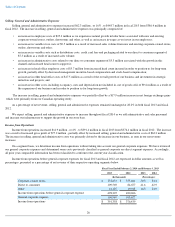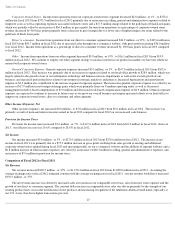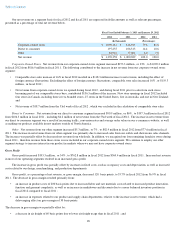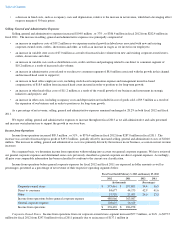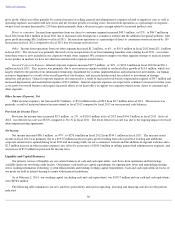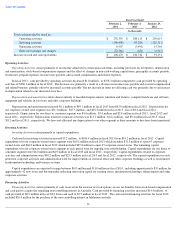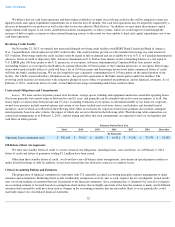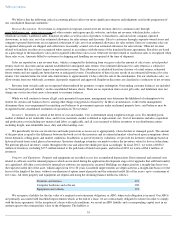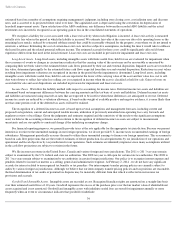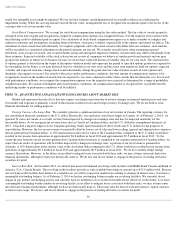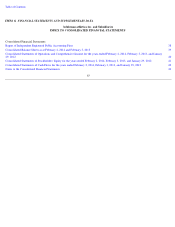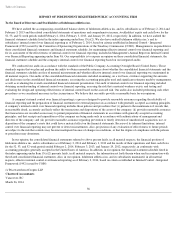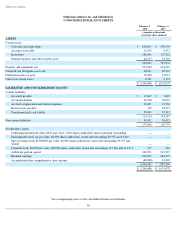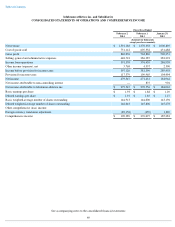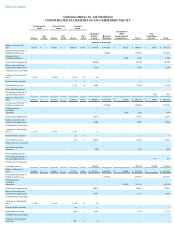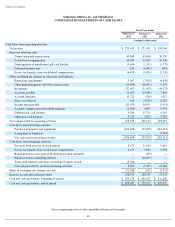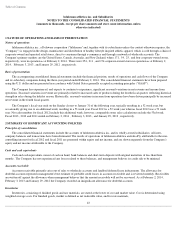Lululemon 2013 Annual Report Download - page 41
Download and view the complete annual report
Please find page 41 of the 2013 Lululemon annual report below. You can navigate through the pages in the report by either clicking on the pages listed below, or by using the keyword search tool below to find specific information within the annual report.
Table of Contents
estimated based on a number of assumptions requiring management's judgment, including store closing costs, cost inflation rates and discount
rates, and is accreted to its projected future value over time. The capitalized asset is depreciated using the convention for depreciation of
leasehold improvement assets. Upon satisfaction of the ARO conditions, any difference between the recorded ARO liability and the actual
retirement costs incurred is recognized as an operating gain or loss in the consolidated statements of operations.
We recognize a liability for a cost associated with a lease exit activity when such obligation is incurred. A lease exit activity is measured
initially at its fair value in the period in which the liability is incurred. We estimate fair value at the cease-use date of its operating leases as the
remaining lease rentals, reduced by estimated sublease rentals that could be reasonably obtained for the property, even where we do not intend to
enter into a sublease. Estimating the cost of certain lease exit costs involves subjective assumptions, including the time it would take to sublease
the leased location and the related potential sublease income. The estimated accruals for these costs could be significantly affected if future
experience differs from that used in the initial estimate. Lease exit costs are included in provision for impairment and lease exit costs.
Long-Lived Assets. Long-lived assets, including intangible assets with finite useful lives, held for use are evaluated for impairment when
the occurrence of events or changes in circumstances indicates that the carrying value of the assets may not be recoverable as measured by
comparing their net book value to the estimated future cash flows generated by their use and eventual disposition. Impaired assets are recorded at
fair value, determined principally by the estimated future cash flows expected from their use and eventual disposition. Reductions in asset values
resulting from impairment valuations are recognized in income in the period that the impairment is determined. Long-lived assets, including
intangible assets with finite useful lives, held for sale are reported at the lower of the carrying value of the asset and fair value less cost to sell.
Any write-downs to reflect fair value less selling cost is recognized in income when the asset is classified as held for sale. Gains or losses on
assets held for sale and asset dispositions are included in provision for impairment and lease exit costs.
Income Taxes. We follow the liability method with respect to accounting for income taxes. Deferred income tax assets and liabilities are
determined based on temporary differences between the carrying amounts and the tax basis of assets and liabilities. Deferred income tax assets
and liabilities are measured using enacted tax rates that are expected to be in effect when these differences are anticipated to reverse. Deferred
income tax assets are reduced by a valuation allowance, if based on the weight of available positive and negative evidence, it is more likely than
not that some portion or all of the deferred tax assets will not be realized.
The recognition of a deferred income tax asset is based upon several assumptions and management forecasts, including current and
proposed tax legislation, current and anticipated taxable income, utilization of previously unrealized non-operating loss carry forwards and
regulatory reviews of tax filings. Given the judgments and estimates required and the sensitivity of the results to the significant assumptions
used, we believe the accounting estimates used in relation to the recognition of deferred income tax assets are subject to measurement
uncertainty and are susceptible to a material change if the underlying assumptions change.
For financial reporting purposes, we generally provide taxes at the rate applicable for the appropriate tax jurisdiction. Because our present
intention is to reinvest the unremitted earnings in our foreign operations, we do not provide U.S. income taxes on unremitted earnings of foreign
subsidiaries. Management periodically assesses the need to utilize these unremitted earnings to finance our foreign operations. This assessment is
based on cash flow projections that are the result of estimates of future production, fiscal requirements by tax jurisdiction of our operations and
operational and fiscal objectives by tax jurisdiction for our operations. Such estimates are inherently imprecise since many assumptions utilized
in the cash flow projections are subject to revision in the future.
We file income tax returns in the United States, Canada and various foreign and state jurisdictions. The 2011 to 201 3 tax years remain
subject to examination by the U.S. federal and state tax authorities. The 2008 tax year is still open for certain state tax authorities. The 2008 to
201 3 tax years remain subject to examination by tax authorities in certain foreign jurisdictions. Our policy is to recognize interest expense and
penalties related to income tax matters as a selling, general and administrative expense. At February 2, 2014 , we do not have any significant
accruals for interest related to unrecognized tax benefits or tax penalties. Our intercompany transfer pricing policies are currently subject to
audits by various foreign tax jurisdictions. Although we believe that our intercompany transfer pricing policies and tax positions are reasonable,
the final determination of tax audits or potential tax disputes may be materially different from that which is reflected in our income tax
provisions and accruals.
Goodwill and Intangible Assets. Intangible assets are recorded at cost. Reacquired franchise rights are amortized on a straight-line basis
over their estimated useful lives of 10 years. Goodwill represents the excess of the purchase price over the fair market value of identifiable net
assets acquired and is not amortized. Goodwill and intangible assets with indefinite useful lives are tested for impairment annually or more
frequently when an event or circumstance indicates that goodwill or indefinite
34


